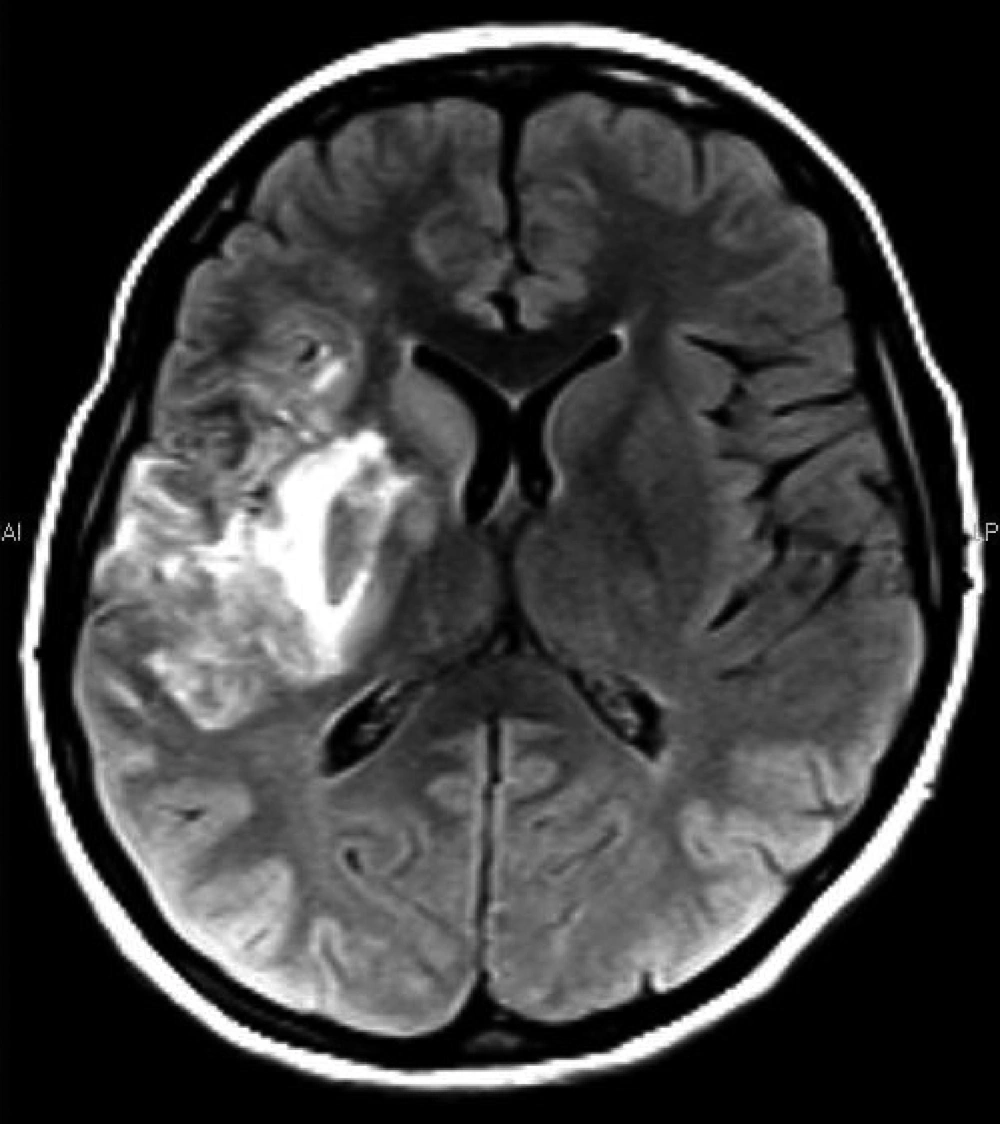1. Introduction
Abiotrophiadefectiva was previously known as a member of the nutritionally variant streptococcus (NVS) (1). The NVS was first described in 1961 by Hirsch and Frenkel as new types of viridans streptococci according to phenotypic characteristics (2). This microorganism is a member of the normal flora of mouth, urogenital and intestinal tracts. It causes various infections such as bacteriemia, brain abscess, septic arthritis and rarely infective endocarditis (3, 4). Only < 1% of all cases of endocarditis are caused by A. defectiva (1). Abiotrophia species causing endocarditis represent 5-6 % of all streptococcal endocarditis cases (5).
2. Case Presentation
A-23-year-old previously healthy female admitted to emergency service of a university hospital with complaints of left hemiplegia for a few hours. The patient had a history of left leg pain for 3 months. Also, there was history of a tooth extraction followed by intermittant fever and maculopapuler rash on her legs at the beginning of the leg pain. These symptoms were resolved without any treatment. A few weeks later, symptoms were resurfaced and the patient was given methotrexate 10 mg /week + prednisolone 10 mg/day with the diagnosis of rheumatoid arthritis ten days before.
On admission, her temperature was 36.8°C, and the pulse was 98 beats per minute, with the blood pressure of 162/104 mmHg. On physical examination, petechial rashes were detected on her palmar and plantar regions. Her blood values were; white blood cell count, 7.860/mm³; hgb, 9, 8 g/dL; platelet count, 266.000 /mm³;C-reactive protein (CRP), 2,12 mg/dL; erytrocyte sedimentation rate (ESR), 72 mm/h. Previous laboratory result for rheumatoid factor were 25, 6 IU/mL and C-reactive protein was 9,13 mg/dL. The magnetic resonance images of the brain revealed acute enfarctus in the striatocapsuler area and a total occlusion was detected in the right median common arterial segment M1 with MR angiography (Figure 1).
Urgent thrombectomy was performed. Echocardiography demonstrated a mobile vegetation on the mitral valve leaflet. Infective endocarditis was diagnosed using modified Duke’s criteria (6). Ceftriaxone 2gr/day and vancomycin 2 gr/day were started to the patient. On the 3rd day after the treatment, her femoral pulse disappeared and femoral thrombus was detected with doppler ultrasound. Femoral thrombectomy was done concurrently with mitral valve replacement.
Three sets of blood cultures were positive for Gram-positive coccobacillus. Gram-positive coccobacillus grown in chocolate blood agar was identified as A. defectiva. Antibiotic was changed to -ampicillin/sulbactam 8 gr/day + vancomycin 2 gr /day. Blood cultures collected at the end of the first week of antimicrobial treatment were sterile. Antibiotics were continued for 6 weeks where ampicillin/sulbactam mono therapy ensued after third week. At the end of therapy, laboratory findings were as follows: white blood cell count: 9.4000/mm³, hgb:11, 1 g/dL, platelet count: 413.000 /mm³, CRP:0,9 mg/dL, ESR:30 mm/h. By the end of six weeks, the patient recovered from endocarditis and discharged. However, the hemiplegia continued and physiotherapy was prescribed.
3. Discussion
Nutritionally variant streptococci were first described in 1961(2). Later, NVS was classified into Streptococcus adjacens and S. defectives in 1989. In 1995, A. defectiva was reclassified independently as Abiotrophia genus based on RNA analysis (1). This fastidious microorganism has been reported to be a common cause of culture-negative bacterial endocarditis (7). Prior heart disease such as congenital valvular heart disease or heart valve prosthesis, dental manipulations were considered as risk factors for A. defectiva endocarditis as another streptococcal endocarditis. The antibiotic regimen of A. defectiva endocarditis should include penicillin or ampicillin plus an aminoglycoside or vancomycine in case of antimicrobial resistance for 4 to 6 weeks (1, 3, 5).
Infective endocarditis caused by A. defectiva and other NVS has a higher mortality, morbidity and complication rates than those caused by other viridans streptococci. The identification and cultivation of A. defectiva is very difficult because it is a delicate microorganism which grows rather gently and scarcely than other streptococci (1, 3). In case series of endocarditis caused by NVS; relapse occurred in 17% of cases, bacteriological failure in 41 % of cases (8). Infective endocarditis due to A. defectiva progresses slowly, despite its sensitivity to antimicrobials nearly half of the cases need surgical management (4). This slowly growing microorganism can unusually result and present with such morbidity like cerebrovasculary disease and hemiplegia as our patient. Morbidity and mortality rates are higher than those associated with other forms of viridans streptococcal and enterococcal endocarditis. Although the bactericidal effect was demonstrated in vitro, antibiotic therapy failed in 41% of patients. About 27 % of patients required heart valve replacement surgery and mortality rate was approximately 20 % (7).
Heart failure is the most serious complication of endocarditis and often requires valve replacement (3). Persistent sepsis, persistent vegetations, severe congestive heart failure and recurrent embolism are major indications for surgical management. A. defectiva caused endocarditis is difficult to cure (5). Prolonged antibiotic treatment is crucial whereas most cases need valve replacement. Previously, mortality and morbidity were reported even in cases with early diagnosis or appropriate antibiotic therapy (7). Our case underwent mitral valve replacement due to extensive valvular damage and recurrent septic embolism. In our patient, because of subacute presentation of the clinical features, the diagnosis could be made after embolization. During the 3 months between initial symptoms and diagnosis, the patient was not evaluated for infectious etiologies until the detection of the cardiac vegetation.
In conclusion, A. defectiva should be considered by clinicians and microbiologists in cases with bacteremia and endocarditis. Favorable outcome can be reached with early diagnosis followed by efficient and prolonged antibiotic treatment and surgical management by the multidisciplinary approach in this rare but risky disease.
